Chapter: Mechanical : Engineering Economics & Cost Analysis : Value Engineering
Value Engineering
VALUE ENGINEERING
INTRODUCTION
Value analysis is one of the major techniques of
cost reduction and cost prevention. It is a disciplined approach that ensures
necessary functions for minimum cost without sacrificing quality, reliability, performance,
and appearance. According to the Society of American Value Engineers (SAVE),
Value Analysis is the systematic application of
recognized techniques which identify the function of a product or service,
establish a monetary value for the function and provide the necessary function
reliably at the lowest overall cost.
It is an organized approach to identify
unnecessary costs associated with any product, material part, component, system
or service by analysing the function and eliminating such costs without
impairing the quality, functional reliability, or the capacity of the product
to give service
1 WHEN TO APPLY VALUE ANALYSIS
One can definitely expect very good results by
initiating a VA programme if one or more of the following symptoms are present:
1. Company’s products show decline in sales.
2. Company’s prices are higher than those of its competitors.
3. Raw materials cost has grown disproportionate to the volume of
production.
4. New designs are being introduced.
5. The cost of
manufacture is rising disproportionate to the
volume of production.
6. Rate of return on investment has a falling trend.
7. Inability of the firm to meet its delivery commitments.
2.Value
The term ‘value’ is used in different ways and, consequently, has different meanings. The designer equates the
value with reliability; a purchase person with price paid for the item; a
production person with what it costs to manufacture, and a sales person with
what the customer is willing to pay.
Example
Cost value. It is the summation of the labour, material, overhead and all
other elements of cost required to produce an item or provide a service
compared to a base.
Exchange value. It is the measure
of all the properties, qualities and features of the product, which make
the product possible of being traded for another product or for money.
Value
analysis/value engineering
It is a special type of cost reduction technique.
It critically investigates and analyses the different aspects of materials,
design, cost and production of each and every component of the product in
produce it economically without decreasing its utility, function or
reliability.
Applications
The various application areas of value engineering
are machine tool industries, industries making accessories for machine tools,
auto industries, import substitutes, etc.
INTRODUCTION
In the process of carrying out business activities
of an organization, a component/product can be made within the organization or
bought from a subcontractor. Each decision involves its own costs.
So, in a given situation, the organization should
evaluate each of the above make or buy alternatives and then select the
alternative which results in the lowest cost. This is an important decision
since it affects the productivity of the organization
In the long run, the make or buy decision is not
static. The make option of a component/product may be economical today; but
after some time, it may turn out to be uneconomical to make the same.
Thus, the make or buy decision should be reviewed
periodically, say, every 1 to 3 years. This is mainly to cope with the changes
in the level of competition and various other environmental factors.
Make or Buy Decisions - is a
determination whether to produce a component part internally or to buy
it from an outside supplier. The Organization should evaluate the costs and
benefits of manufacturing a product or product component against purchasing it
and then select the alternative which results in the lower cost.
1 CRITERIA FOR MAKE OR BUY
In this section the criteria for make or buy are discussed.
1. Criteria for make
The following are the criteria for make:
1.The finished product can be made cheaper by the firm than by
outside suppliers.
2. The finished product is being manufactured only by a limited
number of outside firms which are unable to meet the demand.
3. The part has an importance for the firm and requires extremely
close quality control.
4. The part can be manufactured with the firm’s existing facilities and similar to
other items in which the company has manufacturing experience.
2. Criteria for buy
The following are the criteria for buy:
1. Requires high investments on facilities which are already
available at suppliers plant.
2. The company does not have facilities to make it and there are
more profitable opportunities for investing company’s capital.
3. Existing facilities of the company can be used more economically
to make other parts.
4. The skill of personnel employed by the company is not readily
adaptable to make the part.
5. Patent or other legal barriers prevent the company for making
the part.
6. Demand for the part is either temporary or seasonal.
APPROACHES FOR MAKE
OR BUY DECISION
Types of analysis followed in make or buy decision are as
follows:
1. Simple cost analysis
2. Economic analysis
3. Break-even analysis
1. Simple Cost Analysis
The concept is illustrated using an example problem.
EXAMPLE
A company has extra capacity that can be used to produce a
sophisticated fixture which it has been buying for Rs. 900 each. If the company
makes the fixtures, it will incur materials cost of Rs. 300 per unit, labour
costs of Rs. 250 per unit, and variable overhead costs of Rs. 100 per unit. The
annual fixed cost associated with the unused capacity is Rs. 10,00,000. Demand
over the next year is estimated at 5,000 units. Would it be profitable for the
company to make the fixtures?
Solution
We assume that the unused capacity has alternative use.
Cost to make
Variable cost/unit = Material + labour + overheads
= Rs. 300 + Rs. 250 + Rs. 1 0 0
= Rs. 650
Total variable cost = (5,000 units) (Rs. 650/unit)
=
Rs. 32,50,000
Add fixed cost associated
with unused capacity +
Rs. 10,00,000
Total cost = Rs.
42,50,000
Cost to buy
Purchase cost =
(5,000 units) (Rs. 900/unit)
Add fixed cost associated =
Rs. 45,00,000
with unused capacity +
Rs. 10,00,000
Total cost = Rs.
55,00,000
The cost of making fixtures is less than the cost of buying
fixtures from outside. Therefore, the organization should make the fixtures.
2. Economic Analysis
The following
inventory models are considered to illustrate this concept:
Purchase model
Manufacturing model
The formulae for EOQ and total cost (TC) for each model are
given in the following table:
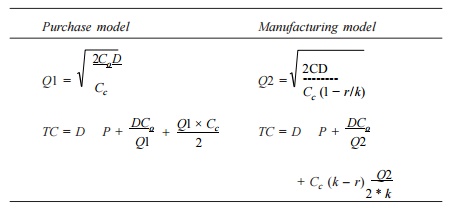
where
D = demand/year
P = purchase price/unit
Cc = carrying cost/unit/year
Co = ordering cost/order or set-up cost/set-up
k = production rate (No. of units/year)
r = demand/year
Q1 = economic order size
Q2 = economic production size
TC = total cost per year
EXAMPLE
An item has a yearly demand of 2,000 units. The different costs
in respect of make and buy are as follows. Determine the best option.
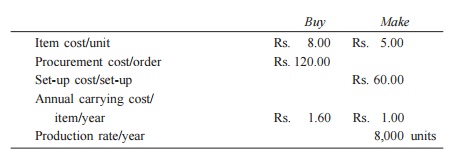
Buy Make
Item cost/unit Rs. 8.00 Rs. 5.00
Procurement cost/order Rs.
120.00
Set-up cost/set-up Rs.
60.00
Annual carrying cost/
item/year Rs. 1.60 Rs. 1.00
Production rate/year 8,000 units
Solution
Buy option
D = 2,000 units/year
Co = Rs. 120/order
Cc = Rs. 1.60/unit/year
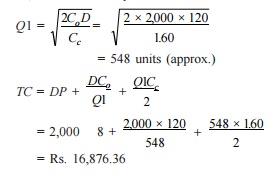
Make option
Co = Rs. 60/set-up
r = 2,000 units/year
Cc = Re 1/unit/year
k = 8,000 units/year
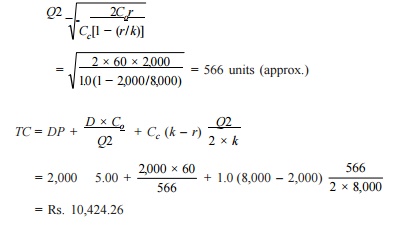
= Rs. 10,424.26
Result: The cost of making is less than
the cost of buying.
Therefore, the firm should go in for the making option.
3. Break-even Analysis
The break-even analysis chart is shown in Fig
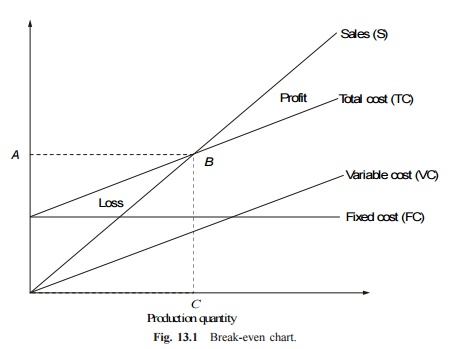
TC = total cost FC = fixed cost
TC = FC + variable cost
B = the intersection of TC and
sales (no loss or no gain situation)
A = break-even sales
= break-even quantity/break-even point (BEP)
The formula for the break-even point (BEP) is
BEP = FC / Selling price / unit − Variable
cost / unit
EXAMPLE
There are three alternatives
available to meet the demand of a
particular product. They are
as follows:
(a) Manufacturing the product
by using process
A (b)
Manufacturing the product
by using
process B (c) Buying the
product
The details are as given in
the following table:

Cost elements Manufacturing ManufacturingBuy
the
product by the product by
process
A process B
Fixed cost/year (Rs.) 5,00,000 6,00,000
Variable/unit (Rs.) 175 150
Purchase price/unit (Rs.) 125
The annual demand of the
product is 8,000 units. Should the company make the
product using process A or
process B or buy it?
Solution
Annual cost of process A = FC + VC Volume
= 5,00,000 + 175 8,000
=
Rs. 19,00,000
Annual cost of process B = FC + VC Volume
= 6,00,000 + 150 8,000
=
Rs. 18,00,000
Annual cost of buy = Purchase price/unit Volume
= 125 8,000
=
Rs. 10,00,000
Since the
annual cost of buy option is
the minimum among
all the alternatives, the company
should buy the product .
Related Topics